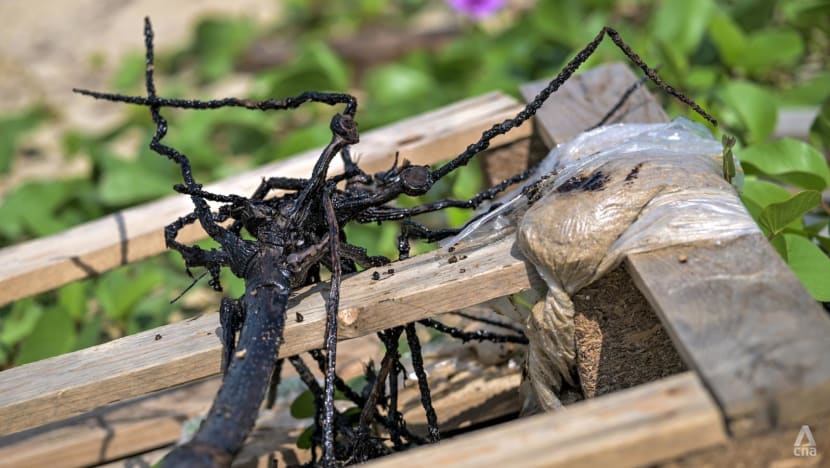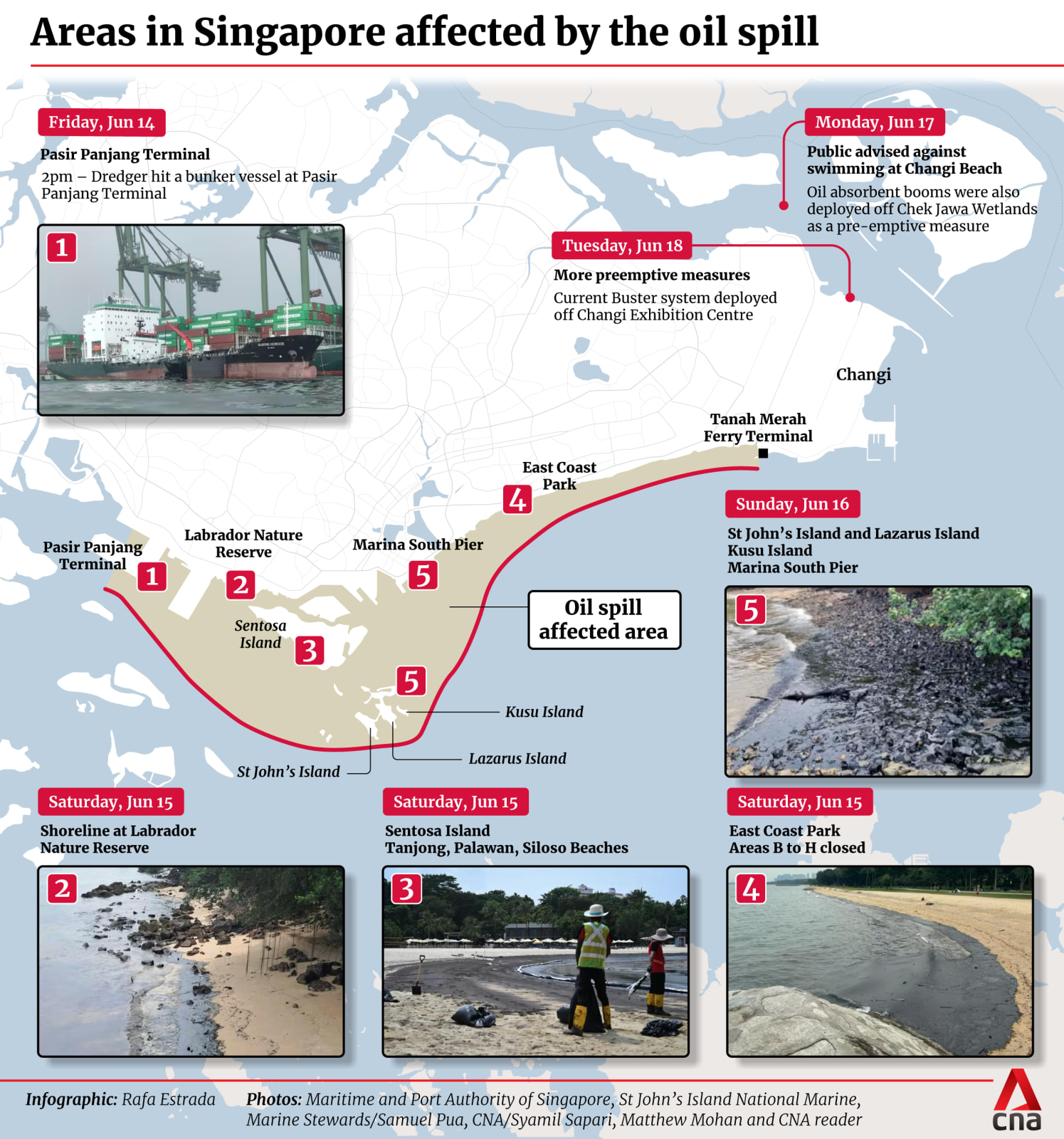Oil spill: Several beaches, including East Coast Park and Sentosa's Siloso, mostly cleared of oil
"We have made progress in the clean-up, but it will still take some time before the oil will be completely removed," says Transport Minister Chee Hong Tat.

Workers scoop oil-soaked sand into trash bags along the shoreline at East Coast Park on Jun 20, 2024. (Photo: CNA/Wallace Woon)

This audio is generated by an AI tool.
SINGAPORE: While several beaches in Singapore have been largely cleared of oil following an oil spill last week, Transport Minister Chee Hong Tat said on Thursday (Jun 20) that it will still take "some time" before the oil is completely removed.
In a joint statement on Thursday, Singapore's authorities said clean-up efforts by the National Environment Agency (NEA) are progressing well at East Coast Park and a "large majority" of oil deposits on the beach had been removed.
The beaches at Tanah Merah have also been largely cleaned up, while the beaches on three Singapore islands - St John's, Lazarus and Kusu - as well as a "large majority" of Sentosa's Siloso beach have been cleared of oily sand, they added.
In a Facebook post, Mr Chee noted the progress made in the clean-up, saying: "Currently, we are focused on cleaning up the oil slicks and sheens from water and land which are visible through drone surveillance and satellite imagery.
"In the next phase, we would need to flush out stranded oil, such as those on oil-stained rock bunds ... The clean-up operation will take some time, and I would like to seek the understanding of members of the public and businesses who are affected by this incident."
On Jun 15, oil washed up along the coast of a number of beaches in Singapore after a Netherlands-flagged dredger, Vox Maxima, hit Singapore-flagged bunker Marine Honour at Pasir Panjang Container Terminal (PPT).
This caused one of the oil cargo tanks on Marine Honour to rupture, spilling about 400 tonnes of low-sulphur fuel into the sea. The resultant oil spill that spread to several coastlines and stained the sand black was not caused by port congestion, Mr Chee said on Tuesday.

CLEAN-UP EFFORTS
The Maritime and Port Authority (MPA), NEA, the National Parks Board (NParks), Singapore's national water agency PUB, the Sentosa Development Corporation (SDC), the Singapore Food Agency (SFA) and the Singapore Land Authority (SLA) on Thursday gave an update on the ongoing clean-up efforts.
They noted that while the beaches at East Coast Park and Tanah Merah have been largely cleaned up, more efforts would likely be required as the tides may continue to sweep in remnants of oil deposits.
The thorough cleaning of the oil-stained rock bunds facing the lagoon at Sentosa's Siloso beach will also start soon. As for Sentosa's Palawan and Tanjong beaches, clean-up efforts are ongoing, with more focused cleaning planned after the clean-up at Siloso beach is completed.
The deployment of containment booms off the three Sentosa beaches have been completed, the authorities said.
"While the beaches remain open and island businesses are operating as per normal, sea activities and swimming are not permitted," they added.
Minister for Sustainability and the Environment Grace Fu said in an update on Thursday evening that more than 71,000kg of oil-soaked sand has been scooped up at the three Sentosa beaches.
"Cleaning the beaches involves a lot of hard work. Immediate focus is to stop the oil spill from spreading inward by deploying booms and removing the oil-soaked sand along the shoreline," she noted in a Facebook post following a visit to Sentosa to better understand the ongoing beach clean-up works.
She added that cleaning oil off rock bunds and breakwaters near beaches is a "complex process" that requires specialised cleaning.
"The rock bunds are not as accessible as beach shorelines and their surfaces are uneven. Oil that has slipped into the boulder crevices also needs to be thoroughly flushed out, and oil within the lagoon needs to be removed," she wrote.


The recovery of accumulated oil off Labrador Nature Reserve and Cooper Channel is ongoing after booms were put in place on Tuesday, in addition to the booms deployed previously to protect Berlayer Creek and the Rocky Shore at the reserve.
While the beaches at St John’s, Lazarus and Kusu Island have been cleared of oily sand, these beaches will be monitored for further signs of oil slicks, the authorities said.
No oil was seen at Changi and Pasir Ris beaches as of Wednesday evening, but NEA will continue to monitor the situation closely. The public are advised not to swim at these beaches or engage in other primary contact water activities as a precaution until further notice.
No oil has also been observed off biodiversity-sensitive areas at Chek Jawa Wetlands at Pulau Ubin, Coney Island Park and Pasir Ris Park.


"Absorbent booms will continue to be deployed there as preventive measures. No oil has been observed off West Coast Park and absorbent booms have been deployed as a precaution to protect the mangroves at the Marsh Garden," said the authorities.
They added that there have not been any reports of oil slicks sighted off Changi since Tuesday.
The northern part of Pasir Panjang Terminal has been cleared of oil slicks since Tuesday, while thorough cleaning using high-pressure jets of Berth 36 - which is near the area where Vox Maxima hit Marine Honour - is ongoing.
In addition to three current busters already deployed - two of them are at western affected areas at PPT and Sentosa, while the other is at eastern affected areas off East Coast and Changi East - the authorities added that another current buster system will be deployed soon.
A current buster is a system that is designed to collect oil on the surface of the water. Towed by two vessels, it sweeps the water's surface, funneling the oil towards an area where it is contained.
Related:
In addition to containment booms laid at the mouth of Keppel Marina, a total of about 20 clean-up personnel and two skimmer systems have been deployed since Tuesday to recover the accumulated oil.
Half-floating on the water’s surface, skimmers lift the oil off the water surface into storage tanks, ensuring that it does not also collect too much sea water in the process.
ONE15 Marina has maintained restricted access to the marina while localised clean-up efforts are ongoing, said the authorities.
They added that Singaporean authorities are in touch with Malaysian counterparts to cooperate on efforts to address any further impact of the oil spill.
Together with Indonesia, Singapore and Malaysia are part of the Revolving Fund Committee, where the three littoral states can request and provide support for oil spills and clean-up operations in the Straits of Malacca and Singapore.
LOCAL FISH, WATER SUPPLY UNAFFECTED
Singapore's fish farms have not been affected by the oil spill to date, the authorities said.
"Nonetheless, as a precautionary measure, the SFA has taken fish samples from coastal fish farms in the East Johor Strait for food safety tests. The test results confirmed that our local fish are safe for consumption."
The drinking water supply in Singapore is also unaffected, with quality reading remaining normal and operations at all desalination plants and reservoirs operating as usual, said PUB.
Air quality at affected areas at East Coast Park, Labrador Nature Reserve and Sentosa "remains well within safe levels", said the authorities.
"NEA will continue to monitor the air quality at the affected areas daily to ensure the safety of the public and personnel involved in the clean-up operations. Information on air quality at affected beaches is published and updated daily on NEA’s website."




















